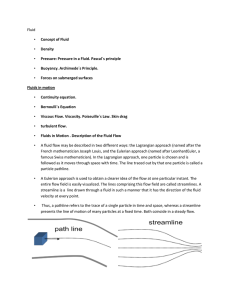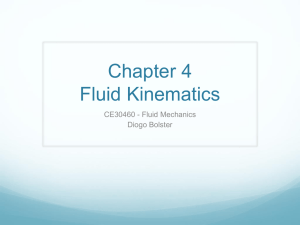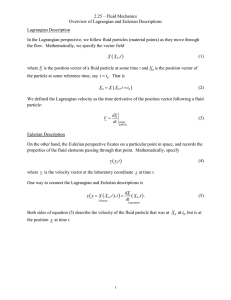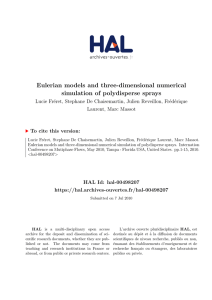1.1 Methods of Describing Fluid Motion CHAPTER 1: BASICS
advertisement
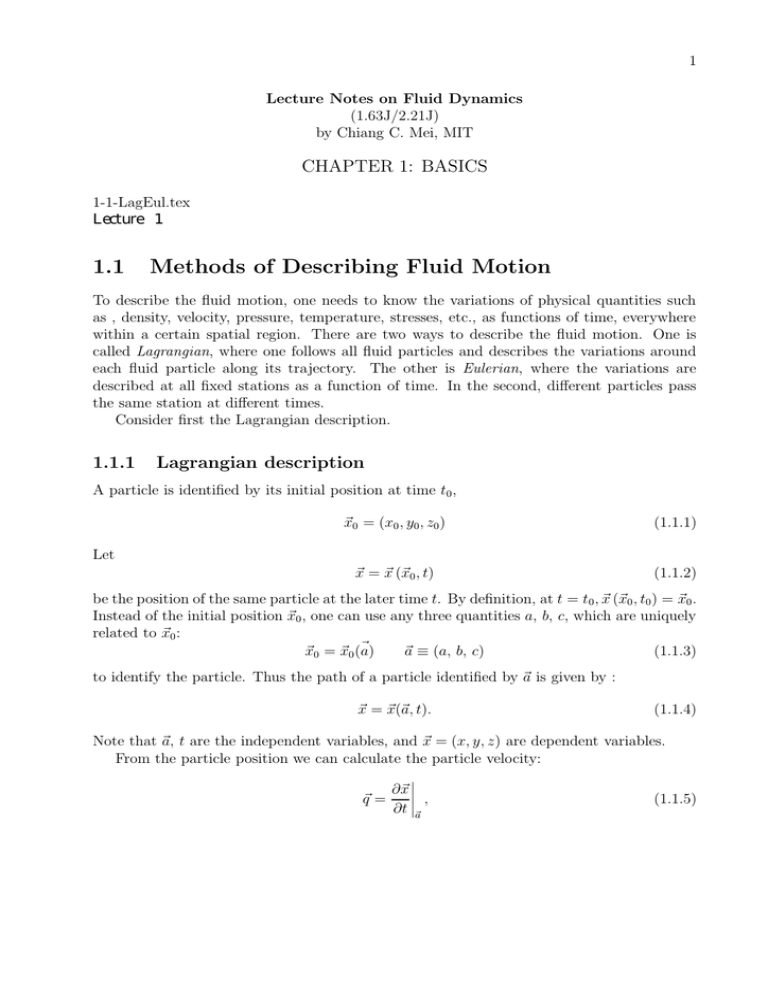
1 Lecture Notes on Fluid Dynamics (1.63J/2.21J) by Chiang C. Mei, MIT CHAPTER 1: BASICS 1-1-LagEul.tex Lecture 1 1.1 Methods of Describing Fluid Motion To describe the fluid motion, one needs to know the variations of physical quantities such as , density, velocity, pressure, temperature, stresses, etc., as functions of time, everywhere within a certain spatial region. There are two ways to describe the fluid motion. One is called Lagrangian, where one follows all fluid particles and describes the variations around each fluid particle along its trajectory. The other is Eulerian, where the variations are described at all fixed stations as a function of time. In the second, different particles pass the same station at different times. Consider first the Lagrangian description. 1.1.1 Lagrangian description A particle is identified by its initial position at time t0 , ~x0 = (x0 , y0 , z0 ) (1.1.1) ~x = ~x (~x0 , t) (1.1.2) Let be the position of the same particle at the later time t. By definition, at t = t0 , ~x (~x0 , t0 ) = ~x0 . Instead of the initial position ~x0 , one can use any three quantities a, b, c, which are uniquely related to ~x0 : ~ ~x0 = ~x0 (a) ~a ≡ (a, b, c) (1.1.3) to identify the particle. Thus the path of a particle identified by ~a is given by : ~x = ~x(~a, t). (1.1.4) Note that ~a, t are the independent variables, and ~x = (x, y, z) are dependent variables. From the particle position we can calculate the particle velocity: ∂~x , q~ = ∂t ~a (1.1.5) 2 as well as the particle acceleration: ∂ 2 ~x ∂~q = . ∂t ~a ∂t2 ~a (1.1.6) Other physical quantities such as density ρ and pressure p can also be expressed in terms of ~a, t, e.g., ρ = ρ (~a, t) , p = p (~a, t) . (1.1.7) 1.1.2 Eulerian Description Here we specify the fluid properties (density, velocity, pressure...) at a fixed point and a chosen time. Thus we are dealing with the time records of a property at a fixed measuring probe. q~ (~x, t) , ρ (~x, t) , p (~x, t) , etc. (1.1.8) Once a physical property of all particles are known at all times, how do we get the property at all fixed points at all times? In other words, how are the Eulerian and Lagrangian systems related? Suppose first that the Lagrangian information of the velocity of all particles are known : q~ = q~ (~a, t) (1.1.9) then we can integrate the definition ∂~x = q~ (~a, t) ∂t (1.1.10) ~x = ~x (~a, t) (1.1.11) for to get the position of a particle, so that x(~a~, 0) = ~a. The result can be inverted in principle to get ~a = ~a (~x, t) (1.1.12) as long as the Jacobian of transformation J= ∂(x, y, z) = ∂(a, b, c) ∂x ∂a ∂y ∂a ∂z ∂a ∂x ∂b ∂y ∂b ∂z ∂b ∂x ∂c ∂y ∂c ∂z ∂c 6= 0. (1.1.13) does not vanish. Once the position of a particle at time t is known, any physical property of a particle can be translated to the property at certain position in space. For example, by substituting (1.1.12) into (1.1.9), we get q~ = q~ (~x, t) , (1.1.14) 3 which gives the Eulerian velocity, i.e., the velocity field at all fixed points. Similarly from the Lagrangian pressure p((~a, t) we get the Eulerian pressure p((~a(~x, t), t) = p(~x, t) Consider next that the Eulerian velocity field is known everywhere: q~ = q~ (~x, t) (1.1.15) Since at t the particle ~a is at ~x (~a, t); the Lagrangian velocity of particle ~a is the same as the Eulerian velocity. Therefore, ∂~x ~q (~x, t) = , (1.1.16) ∂t This equation is a system of nonlinear ordinary differential equations. If they can be solved for ~x = ~x (~a, t) subjected to the initial condition ~x = ~x0 (~a) , t = t0 , we then have ∂~x = ~q [~x (~a, t) , t] ∂t ≡ ~qL (a, t) ≡ q~Lagrangian For the rate of variations we need to calculate derivatives of some physical quantity A (~x, t) whose Eulerian information is given. The rate of variation following a fluid particle is ∂A , ∂t ~a ∂A = ∂A + ∂x ∂t i (Lagrangian) The operator ∂A ∂t ~a ∂xi ∂t ~a = ∂A ∂t ∂A + qi ∂x i (Eulerian) (1.1.17) D ∂ ∂ = + qi (1.1.18) Dt ∂t ∂xi has different names: the substantial, or total, or material derivative. The second term is referred to as the convective rate of variation since it arises because the fluid particle moves to new places. In particular, the acceleration of a fluid particle is ∂ 2 ~x(~a, t) ∂~q D~q = + ~q · ∇~q = . (1.1.19) 2 ∂t ∂t Dt A more physical interpretation of Df /Dt can be derived by using the Eulerian picture directly. Consider f (~x, t). After δt, f (~x, t) is changed to f (~x + q~δt, t + δt). Therefore, the total change of f is δf = f [~x + q~δt, t + δt] − f (~x, t) ! ∂f Df = f (~x, t) + ~q · ∇f + δt − f (~x, t) = δt. ∂t Dt It follows that where ∂f ∂t δf Df ∂f = = + q~ · ∇f δt ~a Dt ∂t is the instantaneous change, and q~ · ∇f is the convective change. (1.1.20)
